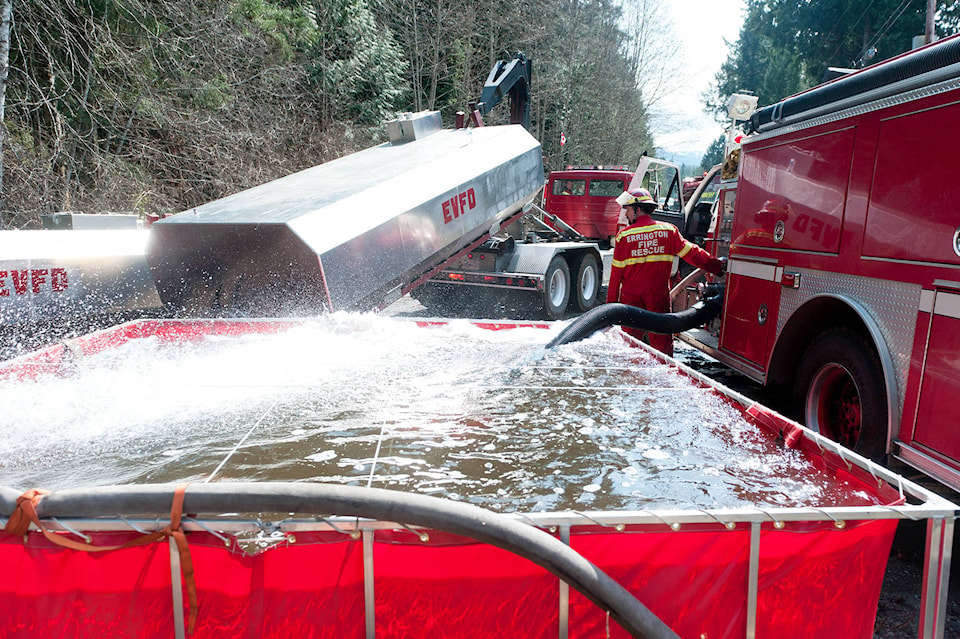As the saying goes, where there’s smoke, there’s fire. The same did not hold true while more than a dozen fire trucks prowled the roads around Errington last weekend with nary a flame in sight.
The trucks and fire crews, representing fire departments from several Vancouver Island communities and one from the Okanagan Valley, were here to take part in the Errington Volunteer Fire Department’s third Super Shuttle training.
The training, designed to prepare firefighters to work in areas without fire hydrants, uses a combination of portable pumps, pumper and tanker trucks and above-ground holding ponds — as well as kilometres of hose — to move water from area streams and ponds to where it is needed in case of a fire.
“We’re the only small (fire) department to have the super shuttle qualification,” said Errington firefighter George Klemm, who organized the scenario-based training that imagined a forest fire bearing down on rural residences between Errington and Englishman River Falls. “This is important to departments that work in areas without hydrant service.”
Klemm said Errington is one of only three departments in B.C. — the others are in Vancouver and Surrey — that boast special portable “pod” tanks, which can be dropped and picked up by custom trucks much like industrial garbage and recycling containers.
The Errington department has two, 2,000-gallon pods and two more 2,700-gallon, aluminum pods, with two trucks able to transport them.
“Having the two trucks and the four pods available is how we got our super shuttle rating,” said Klemm. “If we did the test with conventional tankers, we would have to have four trucks.”
The super shuttle certification means more than something to brag about. Klemm said it allows local rate-payers not serviced by fire hydrants to get a better price on their fire insurance.
For participating departments, several of which work with Errington on mutual aid calls, the training sessions help firefighters work together under a single command, while also familiarizing themselves with the portable pumping and water storage equipment.
“The biggest thing is being able to work with our neighbours,” said Aaron Poirier, Coombs/Hilliers fire chief. “We’re able to provide better service delivery for all our taxpayers; it’s a good model.
The training exercise, which ran both Saturday and Sunday, involved up to 60 firefighters and 15 trucks from Dashwood, Bowser, Coombs/Hilliers, Sooke, East Wellington (Nanaimo) and the Okanagan, as well as a five-man forestry crew from the Coastal Fire District.
It included one component on pumping and transferring water by tanker from area streams and ponds. The other component involved pumping and moving water to large sprinklers and manned water cannons to soak heavily treed areas around homes threatened by the suggested fire scenario.
“I think it’s rather impresive, realizing how many trucks are involved,” said Brad Guthrie, a Dashwood firefighter taking part in his first super shuttle exercise.
“You would think it would be chaos,” added Amanda Cooley, a firefighter from the Nanoose Bay department, another first-time participant. “But I think it’s been really organized and flawless. It’s cool to see how well we work together.”
The result of all the water pumped from local sources into the above-ground “ponds” and then on to tanks and hoses was a humidity bubble around homes that might otherwise be threatened by wildfire due to the lack of a nearby hydrant.
“Basically what we’re doing is laying a lot of fire hose around and creating an above-ground water system,” said Klemm. “It’s like your water main, but it’s all above ground and it’s all temporary.”
